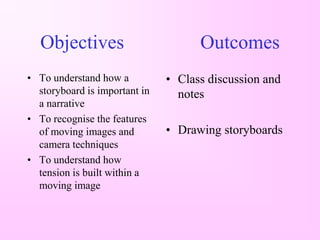Brilliant storyboard
- 1. Objectives Outcomes • To understand how a • Class discussion and storyboard is important in notes a narrative • To recognise the features of moving images and • Drawing storyboards camera techniques • To understand how tension is built within a moving image
- 2. Storyboards Storyboarding is the process of producing sketches of the shots of your script. The end result looks like comic book of your film (without the speech bubbles).
- 3. • Storyboards are used primarily in film making to design individual shots before filming. • They are also common in comic strip, animation, TV commercials, and multimedia design, but can be used for many other sorts of projects.
- 6. Why do them? • It helps you think about how your film is going to look. • Pictures communicate better than words • It allows you to experiment quickly and cheaply, testing out different versions of how a scene may look and play on camera.
- 10. A storyboard should contain: • a sketch of the visual aspect of the screen, • information which will be present, • descriptions of animations, • interactions (e.g. dialog boxes), • sounds, • and any other media.
- 12. Showing Movement • To illustrate movement - whether it’s movement within the frame (actors walking) or the frame moving itself (camera panning etc.) story board artists often use arrows.
- 13. 1. Suppose the camera is tracking in, following a bad guy's footsteps. Draw in an arrow pointing into shot to show the camera's movement. 2. Now the hero's head is pulled back by one of the bad guy's goons. Use an arrow to show the movement of the head being turned. 3. What about a zoom in? From each corner draw in arrows pointing to the centre, draw in a new smaller frame to show the end of the zoom. • Generally use thick white arrows to show camera moves and thin black arrows to show objects moving.
- 14. The Floating Frame There are two options: 1. Illustrate one shot using more than one storyboard frame showing the key stages of the shot's movement across a number of frames or 2. Draw out the entire scene (e.g.. the horizon of a city) and place a frame on it with an arrow indicating the direction of movement.
- 15. Transitions • The storyboard can also include transitions in your film. • Write these in the gaps between the frames e.g.. DISSOLVE TO :
- 16. A quick way of producing a Storyboard 1. Keep the area you have to draw small. 2. Copy up a set of storyboard sheets 3. Sketch in pencil 4. Scribble down short notes 5. Number your shots
- 22. Activity
- 23. Here are a few quick methods for producing storyboards. Keep the area you have to draw small. It allows you to draw much faster. The pictures become more like doodles than works of art. Remember the point is to get an idea of how things will look on screen. Ridley Scott (Blade Runner, Thelma and Louise) is famous for his Ridleygrams – rough, almost indecipherable sketches that outline what he has in mind. Use storyboard sheets like the one that has been handed to you! Sketch in pencil so you can make changes easily, then ink in them in for a professional finish. Scribble down short notes about what's happening in shot (e.g.. BOB enters) what characters are saying ("Is this it? Is this how...") or sound effects (Roll of THUNDER), camera movement (Zoom in) etc. Number your shots so that they can be quickly referred to on the shot list and during editing. Get your pencils acting!
- 24. Guidelines for preparing a Storyboard • Decide what is to be shown • List the visuals in a logical order • Sketch the main elements and what will be in each shot • Describe the type of shot, e.g. LS, CU • If possible give a rough idea of the length of each shot • Explain what sound or dialogue is going on at the same time, e.g music, speech etc. • If someone else is involved in the shooting then make sure that they too can understand the storyboard.

























